Armed with only a solar charger, a vibrator and some marijuana gummy bears, I rode out the pandemic – and my fear of spiders – in a California commune
When Jesus was in the desert for 40 days, the devil tried to lure him off track by tempting him to turn stones into bread. This seems a bit tame on the devil’s part. Lying around in my cave in the Mojave desert, California, at three in the afternoon in 38C (100F) heat, my food fantasies revolve around fish and chips and roasted meat.
Other afternoon activities include gazing at the boulder that looks like a dinosaur with a cheeseburger for a mouth that stands opposite the entrance to my cave. And orgasms. My $99 (GBP70) solar panel does a great job at recharging my phone and my vibrator. Sun-powered orgasms in a prehistoric cave – as rabbits hop past and lizards scuttle across rocks – are fantastic, especially if you’ve eaten a marijuana gummy bear beforehand.
It was creatures that got me into the cave in the first place. Spiders to be precise. In June 2020, I visited a man called Garth, who lives in a tipi, and said that I’d like to move into one of his caves, “because I want to conquer my fear of spiders”.

This was true. A few years ago, I did a couple of “vision quests” in the Pyrenees – four days and nights immersed in nature, inspired by indigenous practices. On my second, I realised I was terrified of spiders, which in shamanic thinking signifies a fear of the feminine (the dark, the damp, the hidden). It struck me that fear of spiders was weird. Why aren’t we afraid of, say, rabbits?
Whatever. I had time on my hands. It was June 2020. A UK citizen, I had finally got a visa to live in the US and based myself in LA. But the Covid apocalypse started to rage and I needed a break from my girlfriend. I was only planning to be in the desert for a month. Forty days, actually. Like Jesus. I might as well have an unusual quarantine, I thought.
I first discovered Garth’s place 10 years ago while on holiday. I’d been doing Palm Springs fabulous for too long, so I drove 40 miles north to an area they call the High Desert. I asked a local shopkeeper if he knew of a “middle of nowhere experience”.
The Joshua Tree area of California is known for its freethinkers. Its charms inspired the Rolling Stones and Jim Morrison to take LSD (Mick likened the vibe to Stonehenge), and nearby in Landers, aircraft mechanic George van Tassel built the Integratron, a white-domed, acoustically perfect would-be time machine, following instructions he claimed to have received from an alien who visited from Venus in 1953.
Garth, 77, seems as big as one of the boulders on his 640-acre Shangri-la bubble. He puts you in mind of Moses, Orson Welles, Grandpa Walton, the Jolly Green Giant, Louis XIV and, occasionally, the tempestuous Queen of Hearts from Alice’s Adventures in Wonderland.
In the late 1970s, he walked the US barefoot, dressed in robes, believing in the guiding power of “spirit”. He belonged to a niche Christian organisation called the Christ Family. He rode on freight trains, slept in bushes and met some pretty interesting people. But he was always being moved on. So in 1980, his father bought him the land for $140,000. Lucky Garth; and lucky for us that he is a generous giant who opens his garden to all who need it.
For the past 41 years, he has been living in a tipi on his property, radiating the message: “Live simple. It makes life a lot easier.”
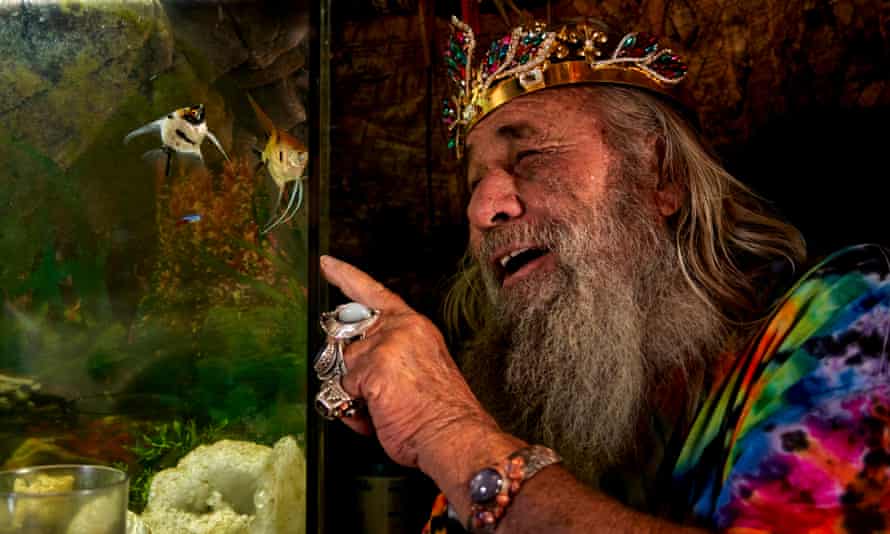
The day I made my cave request, Garth was having lunch in front of his tipi. His huge hand, laden with elaborate costume jewellery, held a fork that dug into a plate of something that looked like diarrhoea over lettuce leaves. It turned out to be boiled and pureed flank steak (a former Mormon, Garth doesn’t like anything too fancy). His favourite garb is a tie-dye T-shirt, basketball shorts and a sombrero adorned with paper butterflies.
My palms started to sweat as I waited for his answer. He finally looked up, held me with his green and yellow eyes, and said: “I used to volunteer in a mental hospital. People had terrible teeth. Puree the meat. Puree the cake. Puree everything.”
He smiled. “I guess I still am in a mental hospital.”
“Oh?” I said.
“Except in hospitals they try to cure you. This land heals you.”
I wasn’t sure what he meant. But Garth said I could stay, so I wandered off, wondering what my malady might be.
The cave is made up of two large boulders that hug each other. Inside, it’s about the size of my old bedroom in London, only it has curves and cracks and natural arches, and is made of golden granite, almost the exact hue of rattlesnake skin. Flecks of black in the white sand are actually rat crap; there is one side that has dark crevasses; and on the wall behind my bed (a wooden board lodged on stones) is a messy-looking spider’s web. This time last summer, I’d pull it down every day, but then the next day it would be up again. I realised I knew nothing about spiders. Are there male and female spiders? How do they meet? What would I do when I eventually saw one? Kill it?
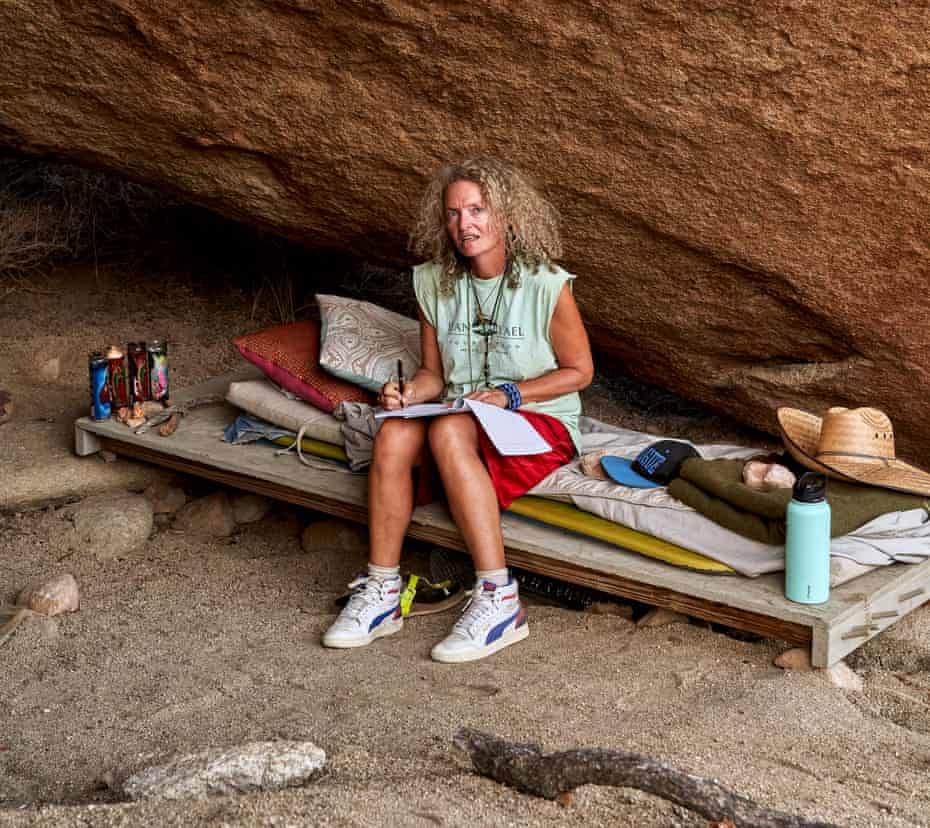
Pxl is a California artist who has lived in a spectacular cave near mine for the past five years. Known as “the boulder house”, it makes you think of The Flintstones meets Studio 54 via 2001: A Space Odyssey. Pxl gave me a pep talk on my first night, saying that after a while you learn which rustling sound is which: lizard rustle, rabbit rustle, chipmunk rustle, rat rustle. Actually, at this point I’d decided to think of them as mice. Rat made me think of huge James Herbert rodents that gouge your eyes out, whereas “mouse” sounded like a maternal Beatrix Potter character in a floral apron.
Pxl produced a black plastic box and told me to keep my food in it so the rats didn’t eat it. When he had gone, I flashed my torch under the base of the board bed. Then I talked to the cave and the creatures.
“Hello everyone,” I said, with a wobbly bravado. “Thanks for letting me stay in your cave. Please make sure there’s not too much action tonight.”
Sleep was fitful. I woke up every hour, waiting for the monsters to come. And then, around 4am, I felt something on my head. I ripped the sheet back and saw what I thought was the shadow of a rodent. I made an “Eek!” sound like a cartoon character in an apron who gets on a chair and screams when she sees a mouse.
I doubt the nuns saw this coming. I went to a convent school in Cornwall during the 1970s and early 1980s, and that certainly put me off religion. For my professional career, I moulded myself into a different type of rock chick, working in lifestyle journalism: fashion, celebrity interviews, parties. In 2004, I was appointed society editor of Harper’s Bazaar, and flew way too close to the dazzling flame. I ended up in a scandal and was referred to as the “notorious lesbian author” in gossip columns. By my mid-40s I was burnt out and sick. What I’m doing now isn’t so different from my previous life: they’re both about extremes.
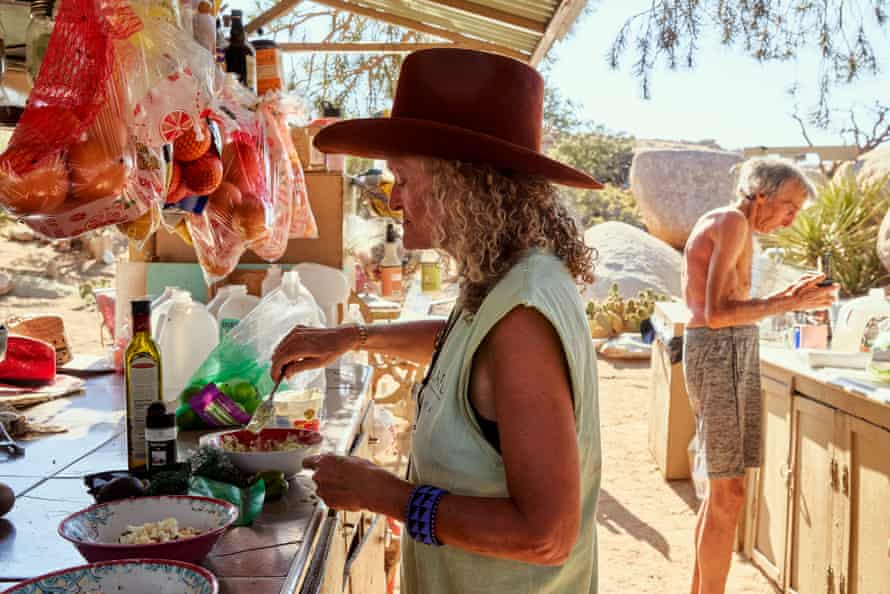
The truth is that the desert is both heaven and hell. In some ways, it’s your living nightmare. All those creatures in your scariest dreams actually exist: take “stink bugs“, big, black beetles whose superpower is squirting a foul-smelling liquid from their bottoms at their enemies. More appalling, though, is that even the creatures which people back in civilisation think are cute are actually terrifying. Take hummingbirds. They hover right in front of you, like feathered sardines with their needle beaks pointing right at your eyes, daring you to flinch.
But the reward for getting through the night is the morning. There are no curtains to open or zips to undo, no “going outside” at all: like the mice and the spiders and the stink bugs, I find myself already in the heart of a world bathed in the clearest of pure light.
I walk out of my cave and down to the Valley of the Kings, as I call it. There are no houses, no people. Some think the “wild west” still exists in the US, but it’s hard to find a place where you can see for miles and miles without human habitation. At Garth’s, it could be the 1800s, or 10 million years ago – or 100 years into the future.
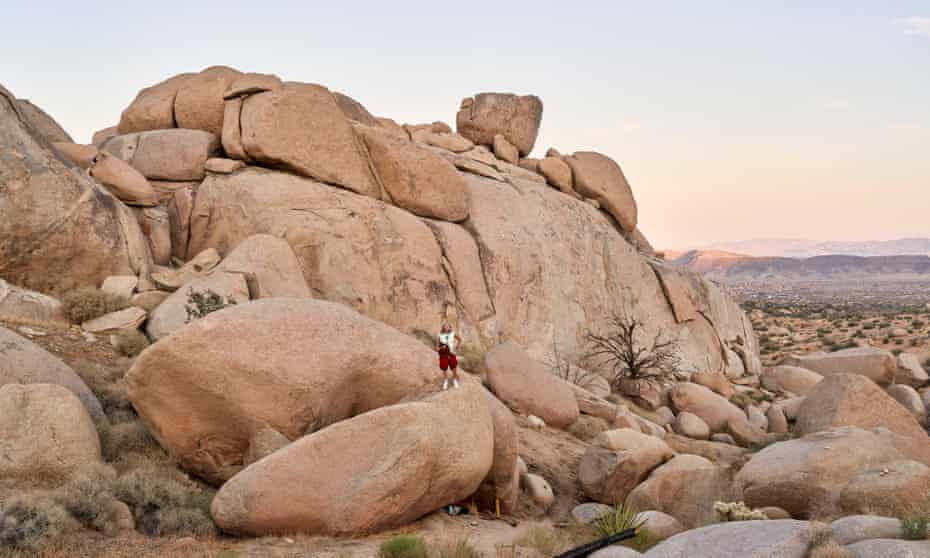
It feels as if a giant walked this way, scattering huge stone eggs as he went. It’s an extraordinary ocean of shapes and attitudes: winking eyes and gaping mouths and goofy smiles. At the bottom of the sandy trail is a boulder escarpment that looks like a gigantic organ in a cathedral with a 1,000-year-old pine tree growing from its pipes. Before it’s even 6am, I might see a coyote or the back of a rabbit that makes me shout out “Bunny!” as if I’m a 10-year-old all over again.
There’s no better place to understand the Lakota nation philosophy of mitakuye oyasin. It means “all my relations” and signifies that we are all connected: those that fly, those that crawl, those that swim, the rocks, the trees, the plants, the two-legged, the four-legged. The eight-legged.
When I told friends I was going to live in the desert, some of them told me I was mad. They said the rattlesnakes would get me. But that’s more two-legged behaviour. Animals are much less calculating. At Garth’s you learn to live alongside them. Sort of.
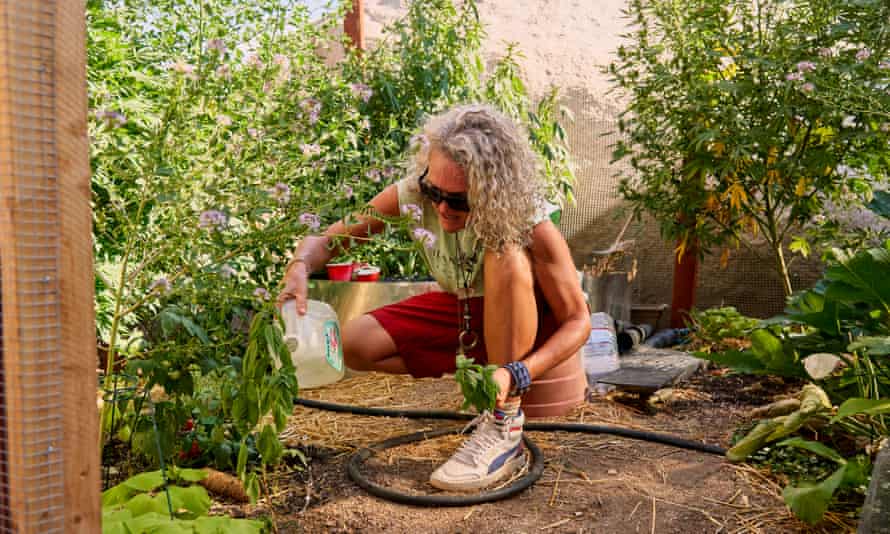
You have to work out your murder policy in the desert. Pxl loves kangaroo mice, and he’ll watch them scamper around his cave with me as he complains about the amount of sugar they’re putting in vegan gummies these days. (First world California problems.) It turns out that desert rats are quite sweet. Not like city rats at all.
But then I came in one day and Pxl said he’d shot a squirrel with an airgun. It died, “like a cowboy in a movie”, he said, doing an impersonation of a squirrel careering backwards with its paws in the air. Nobody in the desert seems to like squirrels. “They pick food up and throw it away,” Pxl says. “They’re like bad neighbours.”

There are about 12 full-time residents. We work two hours a day for our keep: pruning fruit trees, building greenhouses, rat-proofing everything, keeping Garth company. When I first came, I realised I didn’t know anything very practical aside from “righty-tighty, lefty-loosey”. Sometimes I felt really out of place.
A month after I arrived I had a showdown with one of the longtime members, who told me I should be paying to stay here. But relations were restored when I threw myself more into community life. Thanks to my gradual renown as the author of a memoir about self-pleasure, the younger people refer to me as “the masturbation lady”.
Every morning, residents meet up for green juice. We’re an interesting demographic. Greg, 39, is a navy veteran who became addicted to OxyContin. His wake-up call happened when his best friend died from an overdose last year. “The outdoors and the spirituality” have been his saving graces. Victor is in his 80s. A self-styled “metaphysician” who has been here from the beginning. Loni, 61, is the weird scarecrow guy and the valuable fool of the court. Clay, 43, looks at first sight like a gangland boss with his tattooed head, but has the heart of a teddy bear and a soul renewed by the study of shamanism.
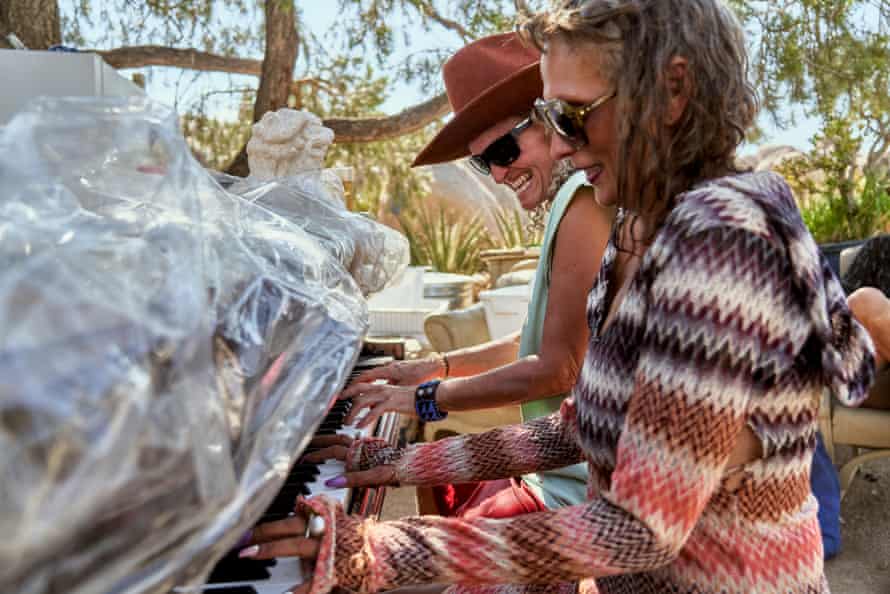
Kyle, a former fashion photographer, manages the place and is passionate about raw eating. There is always salad to eat. I live on avocados, grapefruit, bananas, peanut butter and a pizza blowout once a week when I drive to town. Birdman Rick, who has been here for 20 years, looks after the chickens and peacocks. He started bringing a rattlesnake he’d befriended, Alfredo, up to the green juice mornings. This didn’t go down too well with some of the communards. There’s no HR at Garth’s, just big shouting matches. They tend to blow over, like the desert weather, which never stays the same for long.
There were days, back when I first arrived last June, when nobody seemed to like me here, and yet my friends and my parents on the outside would offer me so much love, and I thought, why the hell am I staying? I guess the answer is: the silence, the space, the sense of “Spirit”.
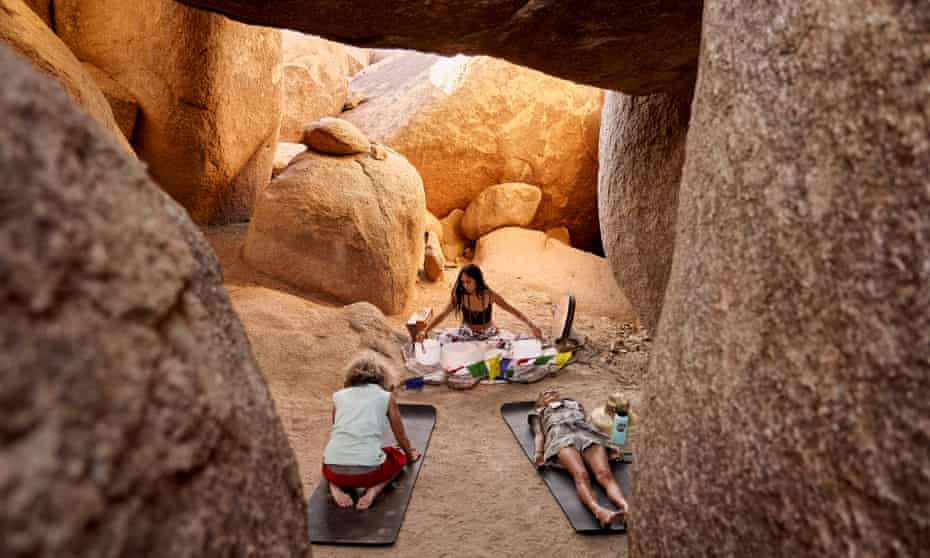
But if Garth’s is a hospital, then the desert herself is the biggest patient of all. In the summer she’s a hot-blooded mistress, but in the winter she’s a deranged attention-seeker screaming with wind. One day I’ll be shivering in seven layers (T-shirt, cashmere jumper, thermal top, hoodie, rabbit-skin jacket and overcoat) and the next I’m sunbathing. In the depths of winter, I put a tent up in the cave. Things were confused by the fact that my menopause had kicked in, so I’d get hot flushes and take off layers – and then Mademoiselle Desert would get the ice back in her heart and I’d have to crawl back into my thermals again.
Whenever I have to leave the cave to go to LA, I make a beeline for the fridge. I shovel various dairy products into my mouth. Then there’s the thrill of indoor plumbing; ablutions that do not involve a shovel and digging a hole. And air conditioning. And mirrors. I discover that some of those age spots are actually dirt.
And yet where is the lizard? Where is the cheeseburger dinosaur? Where is the giant’s garden? And so I return.
I’ve been here more than a year now, long past the quarantine I had initially intended. A couple of US friends have come to visit. One did a brisk walk round and then said he had dinner plans in Palm Springs. The other ooh-ed and ahh-ed and took photos, but then the ice ran out and she got hungry and grumpy.
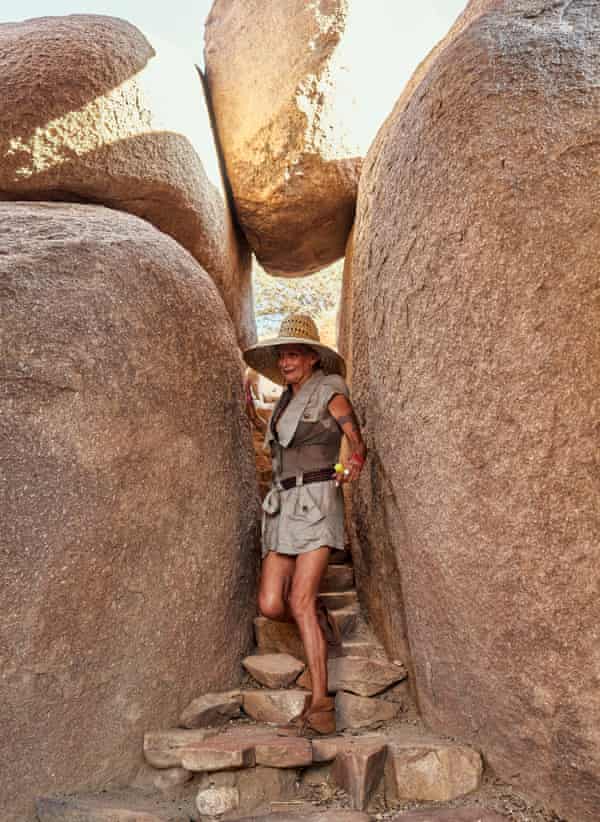
When people ask me when I’m leaving, I wonder: if I’d just moved into an apartment, would they keep asking? My answer is to check out the board you see when you enter the gates. It says “Welcome Home”. And I do feel an irresistible sense of belonging here. My mother started out by saying things like, “You can’t be on holiday for ever, you know.” But these days she’s more interested in knowing if the gopher has come back to the cave, and what a coyote looks like, exactly.
I occasionally speak to friends in the UK on the phone. When my girlfriend and I split up, for instance (I love the desert; she loves LA), I spoke to one of my oldest friends in London, and it felt great to be comforted by someone who really knew me. I have experienced incredible love and camaraderie from my fellow communards when we’re “in our flow”, as we say here, but when we’re not, it can feel lonely. That’s where the lizards and the trees and the stink bugs come in. You can learn a lot from a stinkbug. Take it slowly. Learn to be alone. Have a thick skin.
But there’s still the question of spiders. I finally saw one. In the cave. She was big. She was white. She reminded me of a baby rabbit. Pink skin underneath, and white fur on top. She also resembled a horrifying crab. “This is it. This is the moment,” I kept thinking as my heart pounded. And the longer I looked at her, the more I wanted to touch her. To see if I could understand her better. So I did, and she scuttled off under the rock beneath my pillow. Basically, I’m sleeping on a spider’s nest.
Quick GuideSaturday magazine Show
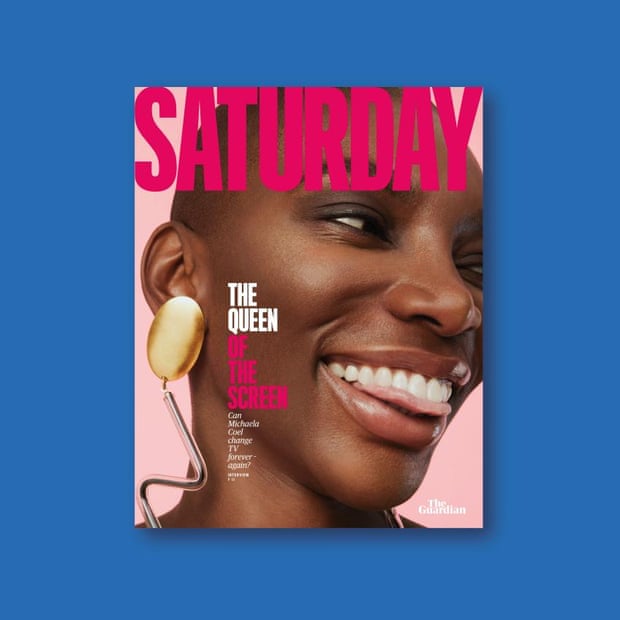
This article comes from Saturday, the new print magazine from the Guardian which combines the best features, culture, lifestyle and travel writing in one beautiful package. Available now in the UK and ROI.
“So what did she feel like?” Carey Ann, the wildcard hairdresser from Palm Springs asked the next morning at green juice.
“She felt … ” I thought for a bit. “Unknowable.”
She shrugged. “My mother was terrified of spiders. I was always killing them for her.” Then she paused. “Maybe you just have to accept that you’re scared of spiders.”
I stopped drinking the juice. I’d never thought of this option. My progress in the hospital continues.